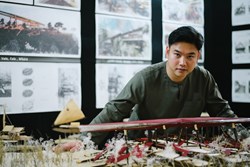2016 Gold Medal: Roger Walker
Roger Walker
Photo by Simon Wilson
Few figures in the history of New Zealand architecture are as synonymous with a place and time as is Roger Walker with Wellington in the Sixties and Seventies.
In those years Wellingtonians only had to look around to see that the times were changing: the Capital’s dramatic topography was a perfect setting for Roger’s flamboyant geometry. His buildings were playful and idiosyncratic assemblages of turrets and towers, cylinders and cubes, portholes and pyramids. Roger’s houses presented a bewildering array of faces to the world and roofs to the sky. This was a wildly inventive architecture by a determinedly free spirit, and it launched a career that has always been characterised by adventurous endeavour and sustained by resilient optimism.
Roger’s drive and his resolve never to be bored may be at least partially attributed to his upbringing in mid-century Hamilton suburbia, an environment he found secure but circumscribed. Fort Nyte, the sizeable and illicit structure he built as a child in the backyard of the family home, prefigured the provocative architecture to come, just as his youthful drawings of fast cars expressed his interest in design and anticipated his devotion to the Ferrari marque. Towards the end of the 1960s, not long out of Architecture School, Roger announced his precocious talent with the design of the Wellington Club, undertaken as a new recruit of Calder Fowler & Styles. This was an extraordinary opportunity for a young graduate, and surely one of the more incongruous pairings of client and design architect in New Zealand architectural history. Roger took his chance with breathtaking confidence and, after a period of juggling his day job and private commissions (he has always had a huge appetite for hard work), he started his own practice.
Over the next decade, Roger designed a series of epoch-defining buildings. A pair of small amenity structures on the Wellington waterfront (1968) popularised the use of white concrete block walls and steeply pitched roofs, and numerous houses on the Capital’s vertiginous hills profoundly influenced perceptions of the New Zealand suburban house, and prompted much imitation. Chief among these radical designs was the Britten House (1973), an exuberant built manifesto that appeared on the cover of The Architectural Review. Even more celebrated, because of its public visibility and larger scale, was Park Mews (1973), the apartment building on the main road to the Hataitai Tunnel that reads as a village of little houses. Park Mews championed communitarian togetherness in the face of the suburban alienation that Roger felt so keenly in his Hamilton childhood. The building was also Roger’s protest against the prevailing uniformity and anonymity of multi-unit residential buildings: who wants to identify their home as the fifth window from the left on the third floor of the second block?
Although his base was in Wellington, Roger’s reputation became national. Roger had already designed St Mary’s Church, Taumaranui (1968) while at Calder Fowler & Styles; in short order he designed the terminal at Whakatane Airport (1971), the Centre Point complex in Masterton (1971) and the Sandcastle Motel on the Kapiti Coast (1972). There was a chain of ice-cream shops in the Bay of Plenty (the Cream Cans, 1974-76), buildings at Rainbow Springs in Rotorua (1974-81), the Waitomo Caves Visitor Centre (1980), and staff accommodation at the Chateau Tongariro (1982). In a conservative society, an unconventional architect had become a marketable brand: just by being himself, Roger was in tune with the zeitgeist.
The pace of Roger’s early career was exhausting and perhaps unsustainable, but undaunted he then started his own housing company, Vintage Homes, which was to be a sustained attempt, enduring through the Eighties and into the Nineties, to marry bespoke design and standardised production. The innovative Vintage Homes project included the house that Roger, ambitiously, entered into the 1981 Ideal Homes Exhibition in Milton Keynes, England.
As his career progressed, Roger continued to design individual homes, but increasingly he turned his attention to medium density housing. He has always been a skilful space planner, a quality recognised by many developers who have commissioned him over the course of several decades. Latterly, Roger has designed multi-unit residential projects in New South Wales and Queensland, and Papakāinga housing in Wellington. His entry into the post-earthquake Breathe Urban Village initiative in Christchurch was a runner-up in the international design competition.
Roger keeps going, and keeps looking forward. He works as hard as he ever did, his curiosity is as strong as it ever was, and his determination to respond in a meaningful way to the building challenges of our cities and suburbs remains undiminished. He is fondly regarded and respected by his clients and his professional peers. He is a worthy recipient of the 2016 New Zealand Institute of Architects Gold Medal.
Download a pdf of Roger Walker's Gold Medal book.




